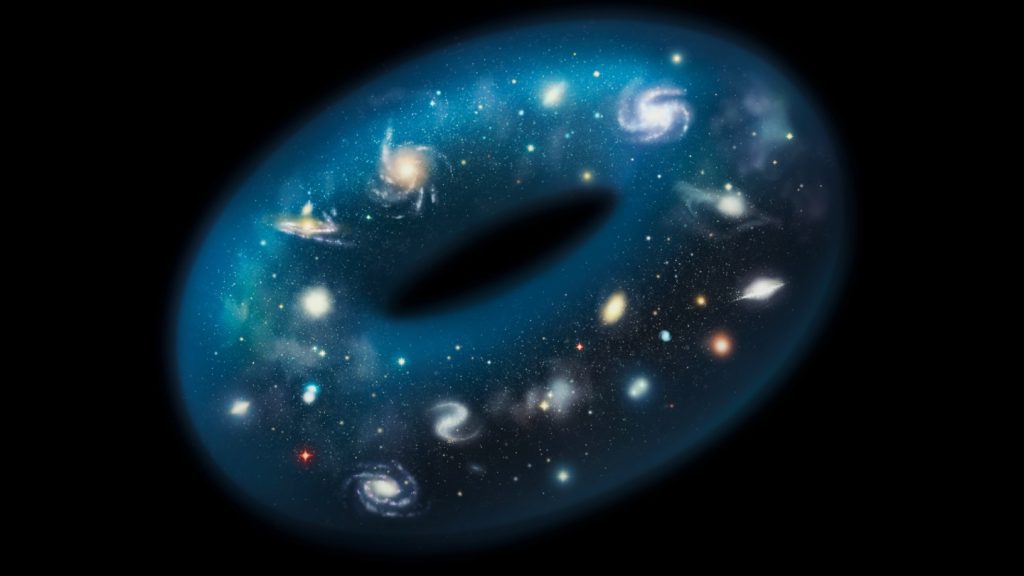The cosmos might share similarities with a doughnut.
Apart from their fried, sweet goodness, doughnuts are known for their shape, or in mathematical terms, their topology. In a universe with a similar, complex topology, you could travel across the cosmos and end up back where you started. Such a cosmos hasn’t yet been ruled out, physicists report in the April 26 Physical Review Letters.
On a shape with boring, or trivial topology, any closed path you draw can be shrunk down to a point. For example, consider traveling around Earth. If you were to go all the way around the equator, that’s a closed loop, but you could squish that down by shifting your trip up to the North Pole. But the surface of a doughnut has complex, or nontrivial, topology (SN: 10/4/16). A loop that encircles the doughnut’s hole, for example, can’t be shrunk down, because the hole limits how far you can squish it.
The universe is generally believed to have trivial topology. But that’s not known for certain, the researchers argue.
“I find it fascinating … the possibility that the universe might have nontrivial or different types of topologies, and then especially the fact that we think we might be able to measure it,” says cosmologist Dragan Huterer of the University of Michigan in Ann Arbor, who was not involved with the study.
A universe with nontrivial topology might be a bit like Pac-Man. In the classic arcade game, moving all the way to the right edge of the screen puts the character back at the left side. A Pac-Man trek that crosses the screen and returns the character to its starting point likewise can’t be shrunk down.
Scientists have already looked for signs of complex topology in the cosmic microwave background, light from when the universe was just 380,000 years old. Because of the way space loops back on itself in a universe with nontrivial topology, scientists might be able to observe the same feature in more than one place. Researchers have searched for identical circles that appear in that light in two different places on the sky. They’ve also hunted for subtle correlations, or similarities, between different spots, rather than identical matches.
Those searches didn’t turn up any evidence for complex topology. But, theoretical physicist Glenn Starkman and colleagues argue, there’s still a chance that the universe does have something in common with a doughnut. That’s because earlier research considered only a small subset of the possible topologies the universe could have.
That subset includes one type of nontrivial topology called a 3-torus, a cube that loops back on itself like a 3-D version of the Pac-Man screen. In such a topology, exiting any side of that cube brings you back to the opposite side. Searches for that simple 3-torus have come up empty. But scientists haven’t yet searched for some 3-torus variations. For example, the sides of the cube might be twisted relative to one another. In such a universe, exiting the top of the cube would bring you back to the bottom, but rotated by, for example, 180 degrees.
The new study looked at 17 different possible complex structures for the universe. Many of these structures are still possible, according to the authors. The study examined the patterns that would show up in the cosmic microwave background for different types of structures. The researchers believe that future studies of this ancient light could reveal clues about these intricate structures.
The search will be difficult in terms of computing, and may require machine learning methods to speed up the calculations. The researchers also plan to search for signs of complex structures in upcoming data from surveys of the distribution of galaxies in the universe, such as from the European Space Agency’s Euclid space telescope. Euclid space telescope (SN: 12/20/23).
There’s a strong reason to search for complex structures, according to Starkman, from Case Western Reserve University in Cleveland. Some characteristics of the cosmic microwave background suggest that the universe is not the same in all directions. SN: 12/23/08 (That kind of unevenness could be explained by complex structures. And that unevenness, Starkman says, is “one of the biggest new mysteries about the universe that hasn’t gone away.”Physicists have not ruled out the possibility that the universe has a complex structure in which space curves back on itself.



